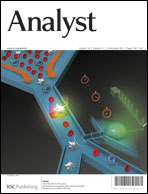Goat anti-rabbit IgG conjugated fluorescent dye-doped silica nanoparticles for human breast carcinoma cell recognition†
Abstract
We report an indirect method for cancer cell recognition using photostable fluorescent silica nanoprobes as biological labels. The dye-doped fluorescent silica nanoparticles were synthesized using the water-in-oil (W/O) reverse microemulsion method. The silica matrix was produced by the controlled hydrolysis of tetraethylorthosilicate (TEOS) in water nanodroplets with the initiation of ammonia (NH3·H2O). Fluorescein isothiocyanate (FITC) or rhodamine B isothiocyanate conjugated with dextran (RBITC-Dextran) was doped in silica nanoparticles (NPs) with a size of 60 ± 5 nm as a fluorescent signal element by covalent bonding and steric hindrance, respectively. The secondary antibody, goat anti-rabbit IgG, was conjugated on the surface of the PEG-terminated modified FITC-doped or RBITC-Dextran-doped silica nanoparticles (PFSiNPs or PBSiNPs) by covalent binding to the PEG linkers using the cyanogen bromide method. The concentrations of goat anti-rabbit IgG covering the nanoprobes were quantified via the Bradford method. In the proof-of-concept experiment, an epithelial cell adhesion molecule (EpCAM) on the human breast cancer SK-Br-3 cell surface was used as the tumor marker, and the nanoparticle functionalized with rabbit anti-EpCAM antibody was employed as the nanoprobe for cancer cell recognition. Compared with fluorescent dye labeled IgG (FITC-IgG and RBITC-IgG), the designed nanoprobes display dramatically increased stability of fluorescence as well as photostability under continuous irradiation.


 Please wait while we load your content...
Please wait while we load your content...